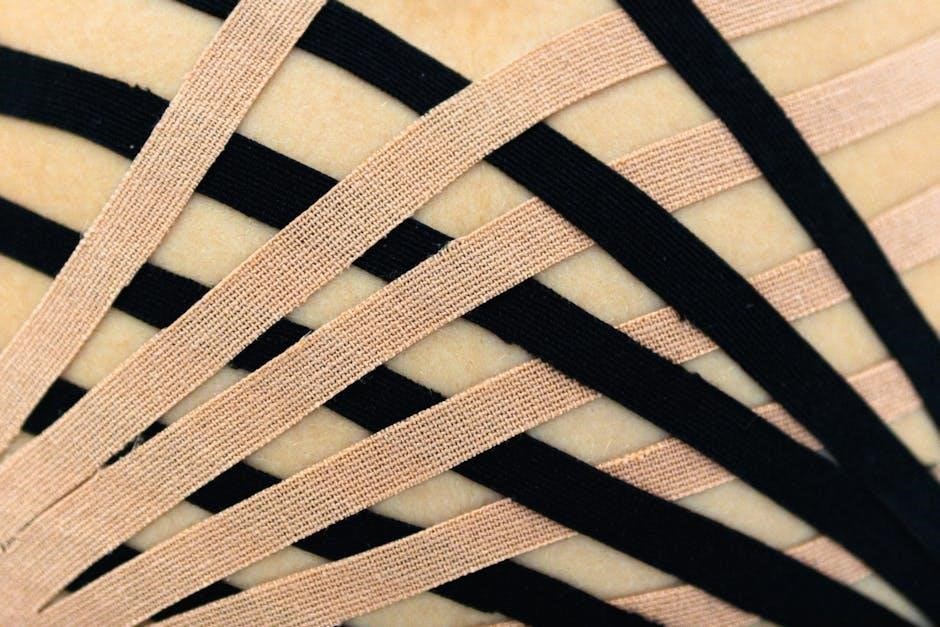
kinesiology taping guide
Learn the art of kinesiology taping with our expert guide, improve performance and reduce pain
Kinesiology taping guide provides information on therapeutic technique
Purpose of Kinesiology Taping
The purpose of kinesiology taping is to provide support and stability to muscles and joints‚ while also improving circulation and reducing pain. This technique is used to enhance athletic performance and aid in rehabilitation.
It is a non-invasive method that can be used in conjunction with other treatments‚ such as physical therapy and massage. The tape is designed to mimic the elasticity of human skin‚ allowing for a full range of motion.
By applying the tape in a specific way‚ it can help to lift the skin and increase interstitial space‚ which can improve blood flow and lymphatic circulation. This can be especially beneficial for athletes and individuals who are recovering from injury.
Overall‚ the purpose of kinesiology taping is to provide a supportive and therapeutic environment that can help to promote healing and improve overall function. The technique is versatile and can be used in a variety of settings‚ from athletic training to clinical rehabilitation.
Definition of Kinesiology Taping
Kinesiology taping refers to the application of elastic adhesive tape to the skin‚ designed to mimic the properties of human skin‚ allowing for a full range of motion.
This technique involves the use of a specialized tape that is applied to specific areas of the body‚ typically over muscles and joints‚ to provide support and stability.
The tape is made from a thin‚ elastic material that is breathable and hypoallergenic‚ making it suitable for use on sensitive skin.
Kinesiology taping is a therapeutic technique that is used to enhance the body’s natural healing processes‚ and is often used in conjunction with other forms of therapy‚ such as physical therapy and massage.
The definition of kinesiology taping is closely tied to its use as a therapeutic tool‚ and is characterized by its focus on providing support and stability to the body‚ while also promoting healing and relaxation.

Benefits of Kinesiology Taping
Kinesiology taping offers numerous benefits for muscles and joints naturally
Pain Relief and Support
Kinesiology taping is used to help decrease pain and muscle spasms that may occur after injury‚ it can help decrease nerves pain signals to the brain.
The tape can be applied to help improve muscular firing and contraction patterns‚ leading to normalized muscular tone.
This can also help improve athletic performance by allowing motion and providing support to the affected area.
Kinesiology taping is a non-invasive technique that can be used in conjunction with other treatments to provide pain relief and support.
The tape is designed to mimic the elasticity of human skin‚ allowing for a full range of motion while providing support and stability to the affected area.
It can be used to help manage pain and inflammation‚ and to provide support and stability to the affected area‚ promoting healing and recovery.
Kinesiology taping can be used to treat a variety of conditions‚ including muscle strains‚ ligament sprains‚ and tendonitis.
The tape can be applied in different ways to provide pain relief and support‚ depending on the specific condition being treated.
Improved Circulation and Muscle Activation
Kinesiology taping can help improve circulation and muscle activation by gently lifting the skin to temporarily increase interstitial space.
This allows for improved blood flow and lymphatic circulation‚ which can help promote healing and reduce inflammation.
The tape can be applied to specific areas to help activate muscles and improve circulation‚ leading to improved overall function and performance.
Improved circulation and muscle activation can also help reduce muscle soreness and fatigue‚ allowing individuals to perform at a higher level.
Kinesiology taping can be used to treat a variety of conditions‚ including edema‚ swelling‚ and poor circulation.
The tape is designed to be worn for an extended period‚ allowing for continuous improvement in circulation and muscle activation.
By improving circulation and muscle activation‚ kinesiology taping can help individuals recover faster and perform better‚ making it a popular choice among athletes and individuals with active lifestyles.
Kinesiology taping is a simple and effective way to improve circulation and muscle activation‚ and can be used in conjunction with other treatments.

Applications of Kinesiology Taping
Kinesiology taping has various applications for rehabilitation and athletic performance purposes always
Rehabilitation and Athletic Performance
Kinesiology taping is used in rehabilitation and athletic performance to enhance stability and support muscles and joints‚ allowing for a full range of motion and improving overall function.
The tape is applied to specific areas of the body to help improve muscular firing and contraction patterns‚ leading to normalized muscular tone and improved athletic performance.
In rehabilitation settings‚ kinesiology taping is used to help decrease pain and muscle spasms that may occur after injury‚ promoting a faster recovery.
The tape can also be used to help improve circulation and reduce swelling‚ which can aid in the healing process.
Additionally‚ kinesiology taping can be used to help improve proprioception‚ or awareness of body position and movement‚ which can be beneficial for athletes and individuals in rehabilitation.
Overall‚ kinesiology taping is a versatile and beneficial technique that can be used to support rehabilitation and athletic performance‚ promoting optimal function and overall well-being.
Non-Invasive Approach
Kinesiology taping offers a non-invasive approach to supporting muscles and joints‚ making it an attractive option for individuals who prefer to avoid invasive treatments.
The tape is applied directly to the skin‚ gently lifting it to increase interstitial space and promote blood flow and lymphatic circulation.
This non-invasive approach allows individuals to receive the benefits of kinesiology taping without the need for surgery‚ injections‚ or other invasive procedures.
The tape is also easy to remove‚ leaving no residue or irritation on the skin.
The non-invasive nature of kinesiology taping makes it a popular choice for athletes‚ individuals in rehabilitation‚ and those seeking pain management.
Overall‚ the non-invasive approach of kinesiology taping provides a safe and effective way to support the body’s natural healing processes‚ promoting optimal function and overall well-being without the need for invasive treatments.

Techniques and Methods

Various kinesiology taping techniques and methods are used to achieve desired outcomes and benefits for the body and muscles naturally and effectively every time with tape application and removal.
Tape Application and Tension
The application of kinesiology tape is a crucial aspect of the therapy‚ requiring careful consideration of tension and technique to achieve optimal results.
Proper tape application involves cleaning and preparing the skin‚ then applying the tape with the desired level of tension‚ which can range from light to heavy.
The tension applied to the tape affects the level of support and stability provided to the muscles and joints‚ with different levels of tension suitable for different conditions and goals.
It is essential to apply the tape in the correct direction‚ taking into account the natural movement and function of the muscles and joints‚ to ensure effective support and stability.
By understanding the principles of tape application and tension‚ individuals can use kinesiology tape to enhance their athletic performance‚ manage pain and inflammation‚ and promote overall health and wellbeing.
Kinesiology tape can be applied in various ways‚ including strips‚ patterns‚ and shapes‚ to target specific areas and achieve specific goals‚ making it a versatile and effective tool for therapeutic use.
Sensitive Skin Considerations
Individuals with sensitive skin require special consideration when using kinesiology tape to avoid discomfort and skin irritation.
The adhesive used on the tape can cause skin reactions in some people‚ so it is essential to choose a hypoallergenic tape or apply a barrier cream to protect the skin.
Applying the tape with a lower level of tension can also help reduce the risk of skin irritation and discomfort.
In addition‚ removing the tape slowly and carefully can help minimize skin irritation and prevent the tape from pulling on the skin.
It is also recommended to do a patch test before applying the tape to a larger area to check for any adverse reactions.
By taking these precautions‚ individuals with sensitive skin can still benefit from the therapeutic effects of kinesiology tape‚ and healthcare professionals can provide effective treatment while minimizing the risk of skin irritation.
This consideration is crucial to ensure safe and effective use of kinesiology tape for all individuals.